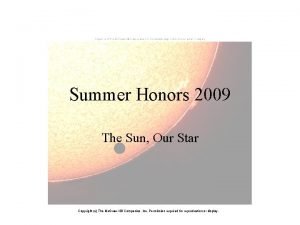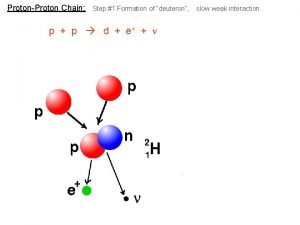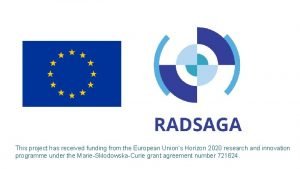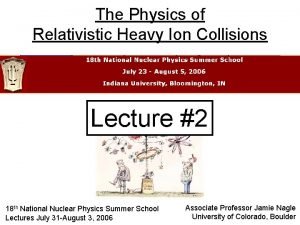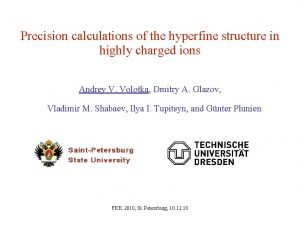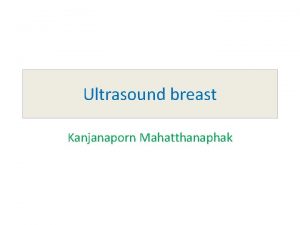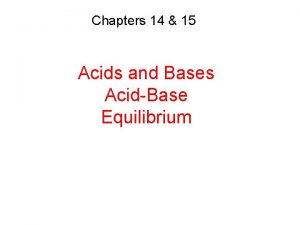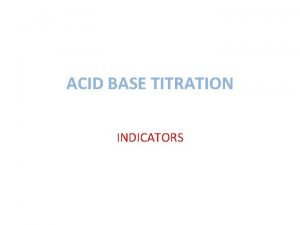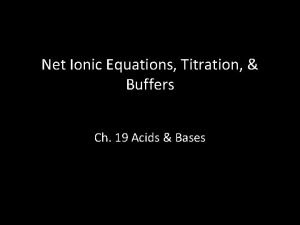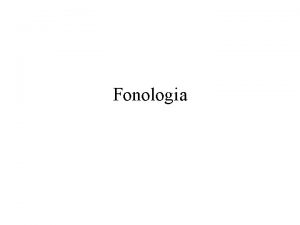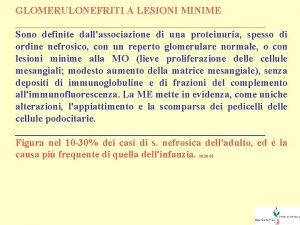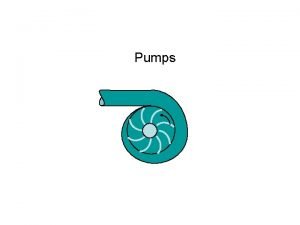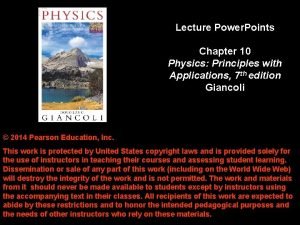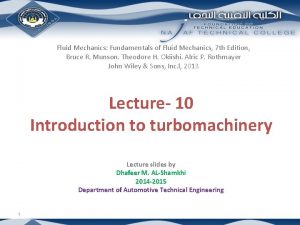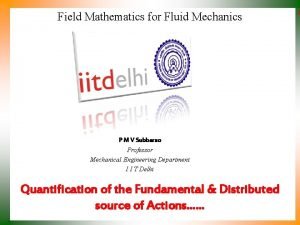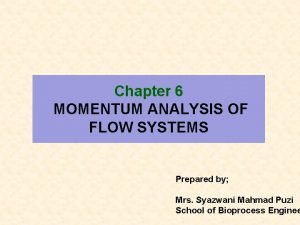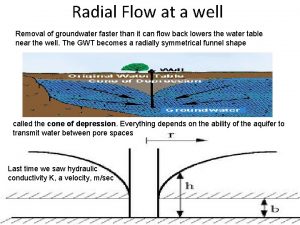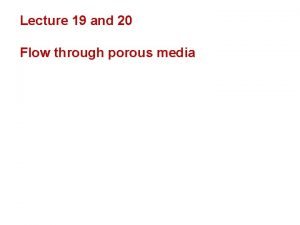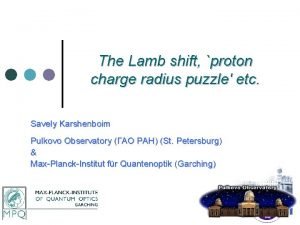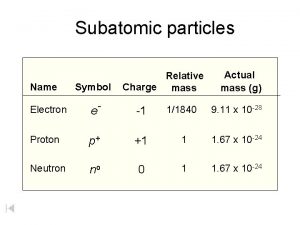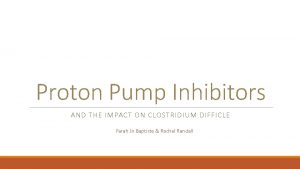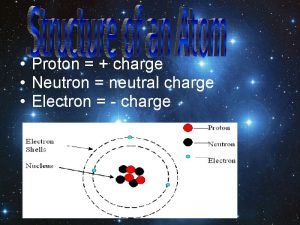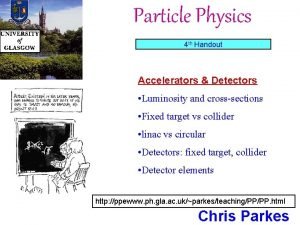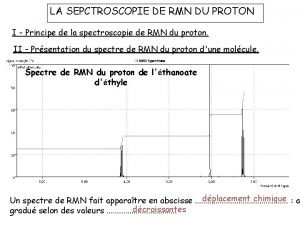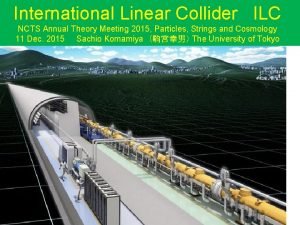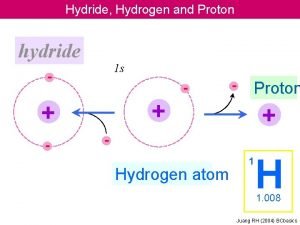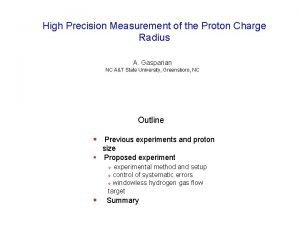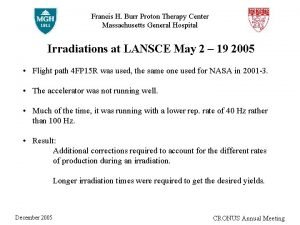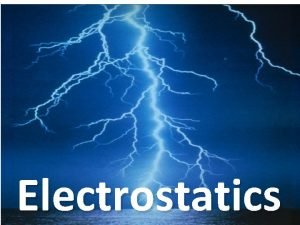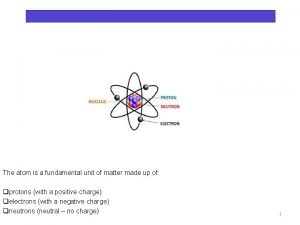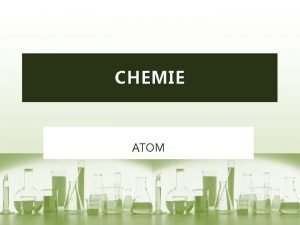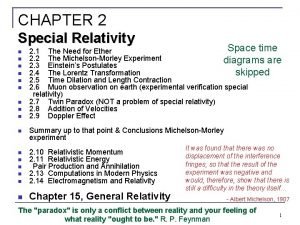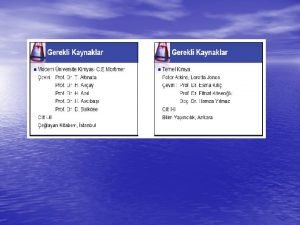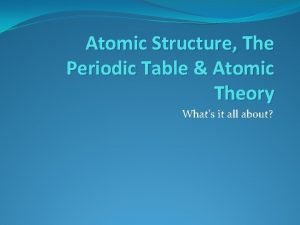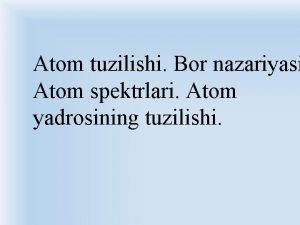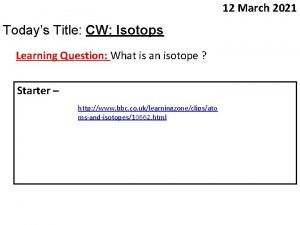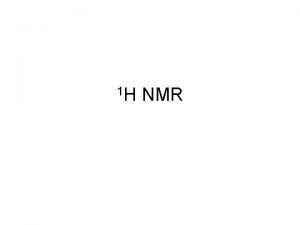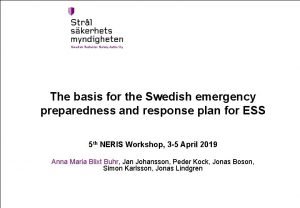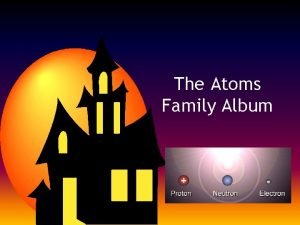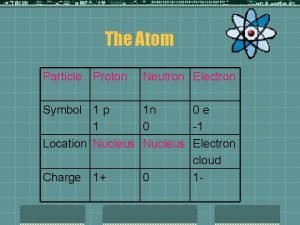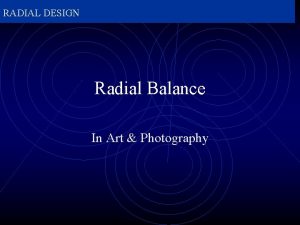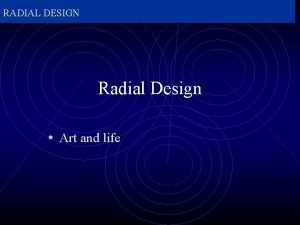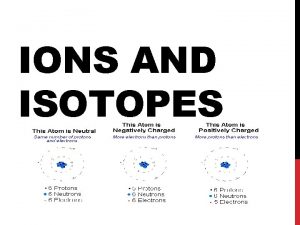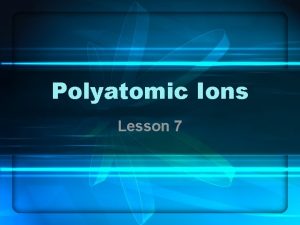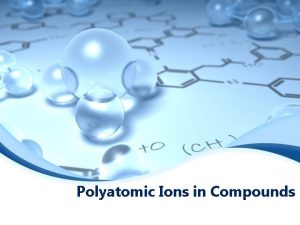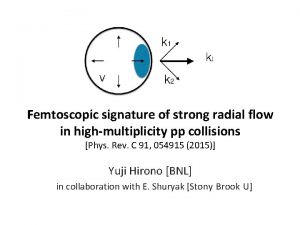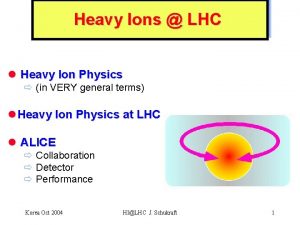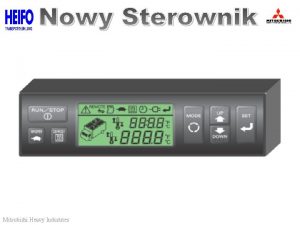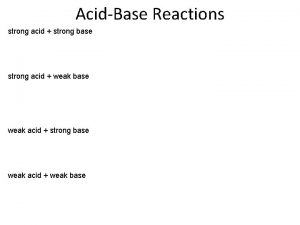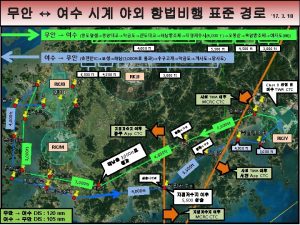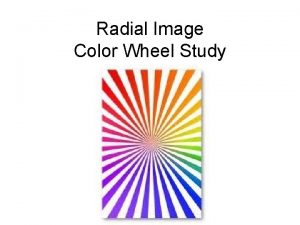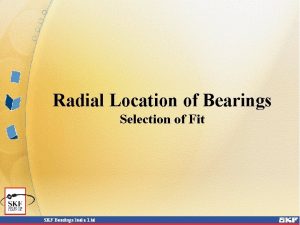Heavy Ions MiniMe Strong radial flow in proton































































![flow in AA, minijets in pp? w flo jets i n i m [2] flow in AA, minijets in pp? w flo jets i n i m [2]](https://slidetodoc.com/presentation_image_h/153545d24b7128c00136143c3d1aa995/image-64.jpg)




- Slides: 68

Heavy Ion’s Mini-Me Strong radial flow in proton collisions at RHIC Hi, I am A+A Hi, I am Mike Lisa Ohio State University p+p ma lisa - Radial Flow in p+p Collisions - CERN Theory Phenomenology Seminar - 16 Oct 2009 1

Outline • What is the importance of flow (what does it tell us)? • What are the signals of radial flow at RHIC? • 2 -particle correlations in p+p collisions at RHIC – femtoscopic & phasespace-induced • Single-particle spectra at RHIC. Effects of phasespace constraints • All together now: consistent treatment of 1 - and 2 -particle distributions – flow “revealed”? – other similarities: yields, “proton anomoly, ” <p. T> vs Nch vs mass • Summary/comments/outlook ma lisa - Radial Flow in p+p Collisions - CERN Theory Phenomenology Seminar - 16 Oct 2009 2

Life as a heavy ion physicist ma lisa - Radial Flow in p+p Collisions - CERN Theory Phenomenology Seminar - 16 Oct 2009 3

paradigms of seeds & watermelons A+A a system “Clean” p+p– a crucial reference at high p. T (do we understand/care about low p. T? ) p+p: a process ma lisa - Radial Flow in p+p Collisions - CERN Theory Phenomenology Seminar - 16 Oct 2009 4

H. I. C. – a system bulk physics • superfluids • superconductors • metal/insulator • … FLOW: most direct proof of existence of system & probe of its response Only for large system - can’t melt one H 20 molecule! ma lisa - Radial Flow in p+p Collisions - CERN Theory Phenomenology Seminar - 16 Oct 2009 5

Explosive flow revealed through specific fingerprints on soft-sector observables calculable in hydrodynamics or toy “blast wave” models R (fm) Spectra v 2 π slow π fast. Kπ but the defining characteristic: correlated position and boost direction HBT STAR PRL 91 262301 (2003) m. T (Ge. V/c) space-momentum substructure mapped in detail ma lisa - Radial Flow in p+p Collisions - CERN Theory Phenomenology Seminar - 16 Oct 2009 6

Obtaining 3 D radii from 3 D correlation functions Au+Au: central collisions C(Qout) typical “Gaussian” fitting function • Au+Au: “Gaussian” radii capture bulk scales • (resonance tails from imaging) C(Qside) • R(p. T) consistent with explosive flow “set of zero measure” of full 3 D correlation fctn 1/RSIDE C(Qlong) ma lisa - Radial Flow in p+p Collisions - CERN Theory Phenomenology Seminar - 16 Oct 2009 7

Spherical harmonic representation of 3 D data (average over m, no “special” direction) ma lisa - Radial Flow in p+p Collisions - CERN Theory Phenomenology Seminar - 16 Oct 2009 8

Spherical harmonic representation of 3 D data QLONG Q θ QSIDE QOUT ϕ Z. Chajecki & MAL, PRC 78 064903 (2008) (average over m, no “special” direction) ma lisa - Radial Flow in p+p Collisions - CERN Theory Phenomenology Seminar - 16 Oct 2009 9

Spherical harmonic representation of 3 D data Au+Au: central collisions C(Qout) C(Qside) C(Qlong) Z. Chajecki & MAL, PRC 78 064903 (2008) ma lisa - Radial Flow in p+p Collisions - CERN Theory Phenomenology Seminar - 16 Oct 2009 10

Spherical harmonic representation of 3 D data d+Au peripheral collisions STAR prelim Z. Chajecki & MAL, PRC 78 064903 (2008) ma lisa - Radial Flow in p+p Collisions - CERN Theory Phenomenology Seminar - 16 Oct 2009 11

Spherical harmonic representation of 3 D data d+Au peripheral collisions Not a “normalization problem” Not a “non-Gaussian” issue STAR prelim (QM 05) A real, non-femtoscopic correlation Z. Chajecki & MAL, PRC 78 064903 (2008) ma lisa - Radial Flow in p+p Collisions - CERN Theory Phenomenology Seminar - 16 Oct 2009 12

We are not alone. . . ma lisa - Radial Flow in p+p Collisions - CERN Theory Phenomenology Seminar - 16 Oct 2009 13

Non-femto correlations in B-E analysis through the years: We are not alone. . . Qx<0. 2 Ge. V/c OPAL, Ge. V/c CERN-PH-EP/2007 -025 Qx<0. 04 (submitted to Eur. Phys. J. C. ) NA 22, Z. Phys. C 71 (1996) 405 CLEO PRD 32 (1985) 2294 Review: Z. Ch. , Acta Phys. Polon. B 40 1119 (2009) ma lisa - Radial Flow in p+p Collisions - CERN Theory Phenomenology Seminar - 16 Oct 2009 14

non-femto “large-Q” behaviour - various approaches • ignore it • various ad-hoc parameterizations • divide by π+π- (only semi-successful, and only semi-justified) • divide by Monte. Carlo PYTHIA, tuning until tail is matched (similar to ad-hoc) • Can we understand it in terms of simplest-possible effect– Energy and Momentum Conservation Induced Correlations (EMCICs)? – Z. Chajecki & MAL, PRC 78 064903 (2008) • see also – p. T conservation effects on v 1 (v 2) [Danielewicz, Ollitrault & Borghini] – p. T conservation on 3 -particle “conical emission” observables [Borghini] – p and E conservation effects on single particle spectra [Chajecki & MAL] ma lisa - Radial Flow in p+p Collisions - CERN Theory Phenomenology Seminar - 16 Oct 2009 15

Phasespace constraints impt @ low multiplicity Phase-space constraints Extreme case, N=3, easily visible with Dalitz plot (k=2) What about the effect for higher number of particles? Dalitz plot for a three-body final state. PDG 2008 ma lisa - Radial Flow in p+p Collisions - CERN Theory Phenomenology Seminar - 16 Oct 2009 18

Fermi/Hagedorn factorization (“Golden rule”) Probability for an n-particle final state: dynamics kinematics Single-particle spectrum R. Hagedorn, Relativistic Kinematics 1963 ma lisa - Radial Flow in p+p Collisions - CERN Theory Phenomenology Seminar - 16 Oct 2009 19

Consider correlations arising (only) from conservation laws The k-particle distribution single-particle “parent” distribution w/o P. S. restriction what we measure no other correlations ma lisa - Radial Flow in p+p Collisions - CERN Theory Phenomenology Seminar - 16 Oct 2009 click here for details 20

k-particle distribution in N-particle system detail –Danielewicz et al, PRC 38 120 (1988) –Borghini, Dinh, & Ollitraut PRC 62 034902 (2000) –Borghini Eur. Phys. J. C 30: 381 -385, (2003) –Chajecki & MAL, PRC 78 064903 (2008) ma lisa - Radial Flow in p+p Collisions - CERN Theory Phenomenology Seminar - 16 Oct 2009 PRC 78 (2008); PRC 79 (2009) 25

N-k=1 is not “large” GENBOD calculation Black area is uniformly filled in. Outside of that area has zero counts Dalitz plot for 3 -particle system: N=3, k=2 calculated numerically by GENBOD* MC * F. James, CERN 1964 Approx weight calculated uniformly in px, py, pz & projected onto M 12 -M 23 ma lisa - Radial Flow in p+p Collisions - CERN Theory Phenomenology Seminar - 16 Oct 2009 26

Overlaid I actually didn’t expect such good agreement in the N=3 case, especially on a Dalitz plot which has the sharpest possible behaviour. ma lisa - Radial Flow in p+p Collisions - CERN Theory Phenomenology Seminar - 16 Oct 2009 27

Effects on single-particle distribution We will return to this…. 1 -particle PS effect N=40 N=5 Z. Chajecki, MAL, PRC 79 034908 (2009) ma lisa - Radial Flow in p+p Collisions - CERN Theory Phenomenology Seminar - 16 Oct 2009 28

k-particle correlation function Dependence on “parent” distrib f vanishes, except for energy/momentum means and RMS 2 -particle correlation function (1 st term in 1/N expansion) for v 2: Danielewicz (84), Ollitrault, Borghini (2000) ma lisa - Radial Flow in p+p Collisions - CERN Theory Phenomenology Seminar - 16 Oct 2009 29

How do EMCICs look ? – nontrivial ! Genbod N=18 <K>=0. 9 Ge. V; PRF - | |<0. 5 event generator (genbod) with only EMCICs O(1/N) term in CLT approximation • structure not confined to large Q • kinematic cuts have strong effect [not shown] ma lisa - Radial Flow in p+p Collisions - CERN Theory Phenomenology Seminar - 16 Oct 2009 30

How do EMCICs look ? – nontrivial ! ma lisa - Radial Flow in p+p Collisions - CERN Theory Phenomenology Seminar - 16 Oct 2009 31

“the system”… a nontrivial concept Characteristic scales of relevant system in which limited energy-momentum is shared • Not known a priori • should track measured quantities, but not be identical to them 1. N includes all primary particles (including unmeasured γ’s etc) 2. secondary decay (resonances, fragmentation) smears connection b/t <E 2> and measured one 3. <E 2> etc: averages of the parent distribution 4. “relevant system” almost certainly not the “whole” (4π) system • e. g. beam fragmentation probably not relevant to system emitting at midrapidity • characteristic physical processes (strings etc): Δy ~ 1÷ 2 • jets: “of the system” ? ? • or just stealing energy from “the system? ” if “relevant system” “whole system”, then total energy-momentum ma lisa • - Radial Flow in p+p Collisions ≠ - CERN Theory Phenomenology Seminar - 16 Oct 2009 will fluctuate e-by-e 32

“the system”… a nontrivial concept Characteristic scales of relevant system in which limited energy-momentum is shared • Not known a priori • should track measured quantities, but not be identical to them • Treat as parameters: what to expect? ma lisa - Radial Flow in p+p Collisions - CERN Theory Phenomenology Seminar - 16 Oct 2009 34

“the system”… a nontrivial concept Characteristic scales of relevant system in which limited energy-momentum is shared • Not known a priori • should track measured quantities, but not be identical to them • Treat as parameters: what to expect? ma lisa - Radial Flow in p+p Collisions - CERN Theory Phenomenology Seminar - 16 Oct 2009 35 35

Femtoscopic correlations and EMCICs (experimentalists’ recipe) Z. Chajęcki & MAL PRC 78 064903 (2008) ma lisa - Radial Flow in p+p Collisions - CERN Theory Phenomenology Seminar - 16 Oct 2009 36

STAR preliminary Fits to p+p data (STAR @ QM 09) k. T = [0. 15, 0. 25] Ge. V/c k. T = [0. 25, 0. 35] Ge. V/c k. T = [0. 35, 0. 45] Ge. V/c k. T = [0. 45, 0. 60] Ge. V/c ma lisa - Radial Flow in p+p Collisions - CERN Theory Phenomenology Seminar - 16 Oct 2009 37

STAR preliminary Fits to p+p data (STAR @ QM 09) k. T = [0. 15, 0. 25] Ge. V/c k. T = [0. 25, 0. 35] Ge. V/c k. T = [0. 35, 0. 45] Ge. V/c k. T = [0. 45, 0. 60] Ge. V/c ma lisa - Radial Flow in p+p Collisions - CERN Theory Phenomenology Seminar - 16 Oct 2009 38

STAR preliminary Fits to p+p data (STAR @ QM 09) k. T = [0. 15, 0. 25] Ge. V/c k. T = [0. 25, 0. 35] Ge. V/c k. T = [0. 35, 0. 45] Ge. V/c k. T = [0. 45, 0. 60] Ge. V/c ma lisa - Radial Flow in p+p Collisions - CERN Theory Phenomenology Seminar - 16 Oct 2009 39

HBT radii (STAR @ QM 09) R Z(fm) 1. Heisenberg uncertainty? Z 0 decay @ LEP p+p and A+A measured in same experiment, • e. g. G. Alexander 2. String fragmentation? (Lund) m. T dep. of HBT radii same - World acceptance, Systematcs same techniques • “plausible” in z-direction • essentially quantitative predictions 3. Resonanceno effects? • unique opportunity to compare physics • unlikely in transvrse • • p dependence maybe (? ? ) T Wiedemann & Heinz ‘ 97 • what causes p. T-dependence in p+p? 4. Flow? ? ? DELPHI • e. g. inconsistent with mult-dep • mass dependence no • • maybe, but will be significantly • same cause as in A+A? Increasingly suggested in 2000] HEP [Andersson, Moriond different effect than for Au+Au experiments HBT R (fm) π K HBT+ “conservation” p Λ Z. Ch. , Acta Phys. Polon. B 40 1119 (2009) hep-ph/0108194 m, m. T (Ge. V) ma lisa - Radial Flow in p+p Collisions - CERN Theory Phenomenology Seminar - 16 Oct 2009 41

Zbigniew Chajecki QM 05 NA 22 Collaboration Z. Phys. C 71, 405– 414 (1996) OPAL Collaboration, Eur. Phys. J. C 52: 787 -803, 2007; ar. Xiv: 0708. 1122 [hep-ex] (hadron-hadron collisions) 1. Heisenberg uncertainty? Z 0 decay @ LEP [based on shape of C(q)…] p+pdata anddo A+A in same experiment, • 2. e. g. G. Alexander String fragmentation? (Lund) Our notmeasured confirm the expectation from same acceptance, same techniques • “plausible” in z-direction the string type model… A good description of • 3. p. Resonance maybe (? ? ) effects? T dependence • unique opportunity to compare physics our data is, however, achieved in the framework • unlikely in transvrse • mass dependence probably no what causes p. T-dependence in source p+p? model. of the • hydrodynamical expanding • 4. e. g. Wiedemann & Heinz ‘ 97 Flow? ? ? DELPHI [Andersson, Moriond 2000] • same cause as in A+A? • • maybe, but will be significantly Increasingly suggested in recent different effect than for Au+Au experiments R Z(fm) femtoscopy in p+p @ STAR R (fm) R 2 tside , R 2 tout and, less markedly, R 2 long decrease with increasing kt. The presence of correlations between the particle production points and K their momenta is an indication that the pion source is not static, but rather expands during the particle emission process. p W. Kittel Acta Phys. Polon. B 32 (2001) 3927 [Review article] … and suggests the existence of an important “collective flow”, even in the system of particles produced in e+e− annihilation! STAR preliminary E 735 Collaboration, PRD 48 1931 (1993) m. T (Ge. V) m, m. T (Ge. V)in heavy-ion collisions also PLB 2002 A 1/√m T scaling first observed is now also observed in hep-ph/0108194 consistent with an expanding shell model. Z fragmentation and may suggest a “transverse flow” even there! ma lisa - Radial Flow in p+p Collisions - CERN Theory Phenomenology Seminar - 16 Oct 2009 43

Zbigniew Chajecki QM 05 NA 22 Collaboration Z. Phys. C 71, 405– 414 (1996) OPAL Collaboration, Eur. Phys. J. C 52: 787 -803, 2007; ar. Xiv: 0708. 1122 [hep-ex] (hadron-hadron collisions) 1. Heisenberg uncertainty? Z 0 decay @ LEP machine” RHIC: “comparison [based on shape of C(q)…] p+pdata anddo A+A in same experiment, • 2. e. g. G. Alexander String fragmentation? (Lund) Our notmeasured confirm the expectation from Vary size. All else fixed. [acceptance, technique…] same acceptance, same techniques • “plausible” in z-direction the string type model… A good description of • 3. p. Resonance maybe (? ? ) effects? T dependence • unique opportunity to compare physics our data is, however, achieved in the framework • unlikely in transvrse • • • mass spectra dependence probably no what causes p. T-dependence in source p+p? model. of the • hydrodynamical expanding Wiedemann & Heinz ‘ 97 4. e. g. Flow? ? ? DELPHI [Andersson, Moriond 2000] • same cause as in A+A? • • • maybe, femtoscopy but will be significantly Increasingly suggested in recent different effect than for Au+Au experiments R Z(fm) femtoscopy in p+p @ STAR R (fm) compare with a system we “know” is flowing. Spect ra R 2 tside , R 2 tout and, less markedly, R 2 long decrease with increasing kt. v The presence of correlations between the particle production points and K 2 their momenta is an indication that the pion source is not static, but rather expands during the particle emission process. p W. Kittel Acta Phys. Polon. B 32 (2001) 3927 [Review article] … and suggests the existence of an important “collective flow”, even in the HB T system of particles produced in e+e− annihilation! STAR preliminary E 735 Collaboration, PRD 48 1931 (1993) m. T (Ge. V) m, m. T (Ge. V)in heavy-ion collisions also PLB 2002 A 1/√m T scaling first observed is now also observed in hep-ph/0108194 consistent with an expanding shell model. Z fragmentation and may suggest a “transverse flow” even there! ma lisa - Radial Flow in p+p Collisions - CERN Theory Phenomenology Seminar - 16 Oct 2009 44

Apples: apples comparison… Z. Chajecki, QM 05 Ratio of (Au. Au, Cu. Cu, d. Au) HBT radii by pp R(p. T) taken as strong space-time evidence of flow in Au+Au • clear, quantitative consistency predictions of Blast. Wave “Identical” signal seen in p+p • cannot be of “identical” origin? (other than we “know it cannot”. . . ) pp, d. Au, Cu. Cu - STAR preliminary ma lisa - Radial Flow in p+p Collisions - CERN Theory Phenomenology Seminar - 16 Oct 2009 45

Significant non-femto correlations, but little effect on “message” STAR preliminary Ratio of (Au. Au, Cu. Cu, d. Au) HBT radii by pp on i t s e gg u s “ ” alternate non-femto Femtoscopy is the most direct probe of explosive radial flow Do p+p collisions flow as much as A+A collisions? ? ? Fit w/o baseline parameterization NEW fit w/ baseline parameterization ma lisa - Radial Flow in p+p Collisions - CERN Theory Phenomenology Seminar - 16 Oct 2009 46

Au+Au 0 -5% Of course not! Au+Au 60 -70% p+p minbias STAR PRL 92 112301 (2004) Blast-wave fit to spectra: • much less explosive flow in p+p collisions ma lisa - Radial Flow in p+p Collisions - CERN Theory Phenomenology Seminar - 16 Oct 2009 48

Au+Au 0 -5% Au+Au 60 -70% p+p minbias STAR PRL 92 112301 (2004) Blast-wave fit to spectra: • much less explosive flow in p+p collisions ma lisa - Radial Flow in p+p Collisions - CERN Theory Phenomenology Seminar - 16 Oct 2009 49

Don’t forget - EMCICs even for k=1 measured “matrix element” “distortion” of single-particle spectra 1 -particle PS effect N=40 Characteristic scales of relevant system in which limited energy-momentum is shared N=5 Z. Chajecki, MAL, PRC 79 034908 (2009) ma lisa - Radial Flow in p+p Collisions - CERN Theory Phenomenology Seminar - 16 Oct 2009 50

measured EMCICs even for k=1 “matrix element” “distortion” of single-particle spectra What if the only difference between p+p and A+A collisions was N? * we remove this absurd assumption soon! Au+Au 0 -5% Au+Au 60 -70% p+p minbias STAR PRL 92 112301 (2004) ma lisa - Radial Flow in p+p Collisions - CERN Theory Phenomenology Seminar - 16 Oct 2009 51

measured EMCICs even for k=1 “matrix element” “distortion” of single-particle spectra What if the only difference between p+p and A+A collisions was N? Then we would measure: ma lisa - Radial Flow in p+p Collisions - CERN Theory Phenomenology Seminar - 16 Oct 2009 52

Multiplicity evolution of spectra - p+p to A+A (soft sector) N evolution of spectra dominated by PS “distortion” p+p system samples same parent distribution, but under stronger PS constraints ma lisa - Radial Flow in p+p Collisions - CERN Theory Phenomenology Seminar - 16 Oct 2009 53

IMPT: What changes with multiplicity…? ma lisa - Radial Flow in p+p Collisions - CERN Theory Phenomenology Seminar - 16 Oct 2009 54

IMPT: What changes with multiplicity…? ma lisa - Radial Flow in p+p Collisions - CERN Theory Phenomenology Seminar - 16 Oct 2009 55

IMPT: What changes with multiplicity…? ma lisa - Radial Flow in p+p Collisions - CERN Theory Phenomenology Seminar - 16 Oct 2009 56

IMPT: What changes with multiplicity…? ma lisa - Radial Flow in p+p Collisions - CERN Theory Phenomenology Seminar - 16 Oct 2009 57

IMPT: What changes with multiplicity…? ma lisa - Radial Flow in p+p Collisions - CERN Theory Phenomenology Seminar - 16 Oct 2009 58

IMPT: What changes with multiplicity…? ma lisa - Radial Flow in p+p Collisions - CERN Theory Phenomenology Seminar - 16 Oct 2009 59

IMPT: What changes with multiplicity…? ma lisa - Radial Flow in p+p Collisions - CERN Theory Phenomenology Seminar - 16 Oct 2009 60

IMPT: What changes with multiplicity…? multiplicity does !! postulate of same parent consistent with all spectra • magnitude • p. T dependence (shape) • mass dependence ma lisa - Radial Flow in p+p Collisions - CERN Theory Phenomenology Seminar - 16 Oct 2009 61

By popular demand (you’ve already seen the impressive result) Almost universal “flow” & “temperature” parameters in a Blast. Wave fit Apparent changes in β, T with d. N/dη caused by EMCICs* ma lisa - Radial Flow in p+p Collisions - CERN Theory Phenomenology Seminar - 16 Oct 2009 63

Hey, that looks like flow!! femtoscopic R(p. T) Hmm… Strong PS constraints on momentum distributions 2 -particle correlations EMCICs <p. T 2> etc. what about PS? single-particle spectra postulate identical parent vary EMCIC <p. T 2> etc. ma lisa - Radial Flow in p+p Collisions - CERN Theory Phenomenology Seminar - 16 Oct 2009 “correct” spectra for EMCICs β, T from BW fit postulate works! 65

Can we do better…? Hey, that looks like flow!! femtoscopic R(p. T) Hmm… Strong PS constraints on momentum distributions 2 -particle correlations EMCICs <p. T 2> etc. what about PS? single-particle spectra postulate identical parent vary EMCIC <p. T 2> etc. ma lisa - Radial Flow in p+p Collisions - CERN Theory Phenomenology Seminar - 16 Oct 2009 “correct” spectra for EMCICs β, T from BW fit postulate works! 66

Can we do better…? Yes we can! femtoscopic R(p. T) 2 -particle correlations β, T from BW fit to HBT and spectra EMCICs <p. T 2> etc. single-particle spectra postulate identical parent vary EMCIC <p. T 2> etc. ma lisa - Radial Flow in p+p Collisions - CERN Theory Phenomenology Seminar - 16 Oct 2009 “correct” spectra for EMCICs β, T from BW fit postulate works! 67

Combined fit: consistent flow-based description STAR Preliminary Use parameters obtained from the fit to STAR femtoscopic correlation function and use them to = [0. 35, 0. 45] Ge. V/c =k. T[0. 35, 0. 45] Ge. V/c “correct”k. Tspectra ma lisa - Radial Flow in p+p Collisions - CERN Theory Phenomenology Seminar STAR - 16 Octpreliminary 2009 68

Combined fit: consistent flow-based description Blast-Wave Model: F. Retiere, MAL, PRC 70: 044907, 2004. ma lisa - Radial Flow in p+p Collisions - CERN Theory Phenomenology Seminar - 16 Oct 2009 69

Combined fit: consistent flow-based description “raw” (ignoring EMCICs) EMCICs fixed by correlations Joint spectra/HBT BW fit EMCICs free adjusted to spectra & fit to spectra EMCICs fixed by correlations Joint spectra/HBT BW fit “raw” (ignoring EMCICs) ma lisa - Radial Flow in p+p Collisions - CERN Theory Phenomenology Seminar - 16 Oct 2009 70

Combined fit: consistent flow-based description “raw” (ignoring EMCICs) EMCICs fixed by correlations p+p collisions Joint spectra/HBT BW fit EMCICs free adjusted to spectra & fit to spectra show same flow signals as A+A collisions EMCICs fixed by correlations Joint spectra/HBT BW fit “raw” (ignoring EMCICs) ma lisa - Radial Flow in p+p Collisions - CERN Theory Phenomenology Seminar - 16 Oct 2009 71

Implication: A+A is just a collection of flowing p+p? • No! Quite the opposite. – femtoscopically • A+A looks like a big Blast. Wave • not superposition of small Blast. Waves • A+A has thermalized globally – spectra • superposition of spectra from p+p has same shape as a spectrum from p+p! • relaxation of P. S. constraints indicates A+A has thermalized globally ma lisa - Radial Flow in p+p Collisions - CERN Theory Phenomenology Seminar - 16 Oct 2009 72

Implication: A+A is just a collection of flowing p+p? • No! Quite the opposite. – femtoscopically • A+A looks like a big Blast. Wave • not superposition of small Blast. Waves • A+A has thermalized globally – spectra • superposition of spectra from p+p has same shape as a spectrum from p+p! • relaxation of P. S. constraints indicates A+A has thermalized globally Hi, I am A+A Hi, I am p+p • rather, p+p looks like a “little A+A” ma lisa - Radial Flow in p+p Collisions - CERN Theory Phenomenology Seminar - 16 Oct 2009 73

PID’d <p. T> systematics similar systematics AA vs pp increasing flow or relaxed P. S ? E 735 PRD 48 984 (1993) ma lisa - Radial Flow in p+p Collisions - CERN Theory Phenomenology Seminar - 16 Oct 2009 STAR E 735 PRD 48 984 (1993) 75

Two effects… or one? p+pbar @ Tevatron p+p, Au+Au @ RHIC EMCICs more flow STAR PRL 92 112301 (2004) more minijets Wang & Gyulassy 1992 Geometric substructure argues against changing flow argument …and for soft sector, a pure minijet mechanism (global x-p correlations) ma lisa - Radial Flow in p+p Collisions - CERN Theory Phenomenology Seminar - 16 Oct 2009 76
![flow in AA minijets in pp w flo jets i n i m 2 flow in AA, minijets in pp? w flo jets i n i m [2]](https://slidetodoc.com/presentation_image_h/153545d24b7128c00136143c3d1aa995/image-64.jpg)
flow in AA, minijets in pp? w flo jets i n i m [2] [1] R. de Souza et al, Phys. Lett. B 300, 29 (1993); I. G. Bearden et al, Phys. Rev. Lett. 78 (1997) 2080 [2] A. Dumitru and C. Spieles, Phys. Lett. B 446, 326 (1999) ma lisa - Radial Flow in p+p Collisions - CERN Theory Phenomenology Seminar - 16 Oct 2009 77

“Anomalously” new physics in AA? “anomolous” p/pi ma lisa - Radial Flow in p+p Collisions - CERN Theory Phenomenology Seminar - 16 Oct 2009 78

Summary 1 • E&M conservation induces phasespace constraints w/ explicit N dependence – should not be ignored in (crucial!) N-dependent comparisons – significant effect on 2 - (and 3 -) particle correlations [c. f. Ollitrault, Borghini, Voloshin…] – …and single-particle spectra (often neglected because no “red flags”) k. T=0. 35 -0. 6 ma lisa - Radial Flow in p+p Collisions - CERN Theory Phenomenology Seminar - 16 Oct 2009 79

Summary 1 • E&M conservation induces phasespace constraints w/ explicit N dependence – should not be ignored in (crucial!) N-dependent comparisons – significant effect on 2 - (and 3 -) particle correlations [c. f. Ollitrault, Borghini, Voloshin…] – …and single-particle spectra (often neglected because no “red flags”) • Femtoscopy & Spectra – in H. I. C. , well understood, detailed fingerprint of flow – RHIC – first opportunity for direct comparison with p+p – accounting for EMCICs, identical flow signals in p+p • collective signals in A+A also seen in hadron-hadron collisions • Has AA become the reference system for pp in non-perturbative sector? ? ? • Thermalization, hadronization, very early color dynamics… – Mrowczynski, Pratt, Broniowski, Strickland, Werner, Venugopalan, … ma lisa - Radial Flow in p+p Collisions - CERN Theory Phenomenology Seminar - 16 Oct 2009 80

Summary 2 - LHC • At RHIC (200 Ge. V), unique apples: apples comparison flow in p+p • At Tevatron (2 Te. V), low statistics soft sector data hinted at flow in p+pbar • At LHC (14 Te. V), most people now expect flow in p+p – and it will be seen – because “multiplicity in p+p @ LHC is similar to Cu+Cu at RHIC” ? ? yes and no ü the high multiplicity will make flow easier to see (less EMCIC “distortion”) we will not have to be so careful as at RHIC ✘but the flow will not be due to the high multiplicity (rescattering or so). – when we observe it, use it as a tool to study general problem of collectivity in hadron collisions ma lisa - Radial Flow in p+p Collisions - CERN Theory Phenomenology Seminar - 16 Oct 2009 81
 Ephesians 6:10-20 nkjv
Ephesians 6:10-20 nkjv Proton proton chain
Proton proton chain Fission definition
Fission definition Proton proton chain
Proton proton chain Carbon trichloride
Carbon trichloride Heavy ions
Heavy ions Heavy ions
Heavy ions Sqed
Sqed Top heavy bottom heavy asymptotes
Top heavy bottom heavy asymptotes Anti radial vs radial ultrasound
Anti radial vs radial ultrasound Strong acid weak base titration
Strong acid weak base titration Weak acid strong base titration curve
Weak acid strong base titration curve How to remember strong acids and strong bases
How to remember strong acids and strong bases Weak acid and strong base titration curve
Weak acid and strong base titration curve Strong acids
Strong acids Buffer solution net ionic equation
Buffer solution net ionic equation Coppie minime linguistica esempi
Coppie minime linguistica esempi La frase minima
La frase minima Glomerulonefrite a lesioni minime guarigione
Glomerulonefrite a lesioni minime guarigione Iao minime
Iao minime Centrifugal pump radial flow
Centrifugal pump radial flow Radial flow centrifugal pump
Radial flow centrifugal pump Pumps fluid mechanics
Pumps fluid mechanics Radial flow centrifugal pump
Radial flow centrifugal pump Radial flow centrifugal pump
Radial flow centrifugal pump Aquifer well
Aquifer well Darcy equation for radial flow
Darcy equation for radial flow Hafoe mask
Hafoe mask Venturi mask vs face mask
Venturi mask vs face mask O2 liters to fio2
O2 liters to fio2 Obstruction type flow meter
Obstruction type flow meter External flow
External flow Flow of energy vs flow of matter
Flow of energy vs flow of matter Flow of energy vs flow of matter
Flow of energy vs flow of matter Dfd to structure chart
Dfd to structure chart Data flow structure
Data flow structure Irrotational flow
Irrotational flow External flow vs internal flow
External flow vs internal flow Data flow vs control flow
Data flow vs control flow Flow diagram of cheddar cheese
Flow diagram of cheddar cheese Control flow and data flow computers
Control flow and data flow computers Control flow vs transaction flow
Control flow vs transaction flow Pass the proton acid-base theories answer key
Pass the proton acid-base theories answer key Proton charge.
Proton charge. Symbols for subatomic particles
Symbols for subatomic particles Proton pump inhibitors mechanism of action flowchart
Proton pump inhibitors mechanism of action flowchart Charge of a neutron
Charge of a neutron Positron vs proton
Positron vs proton Multiferroic
Multiferroic Annual theory meeting
Annual theory meeting Hydride vs proton
Hydride vs proton Proton charge radius
Proton charge radius Francis burr proton therapy center
Francis burr proton therapy center Charge on proton
Charge on proton Charge on proton
Charge on proton Proton vtn
Proton vtn Charge on proton
Charge on proton Kinetic energy of a relativistic particle
Kinetic energy of a relativistic particle Atomda proton nötron yerleri
Atomda proton nötron yerleri Current model of an atom
Current model of an atom Bor nazariyasi
Bor nazariyasi Is sulfuric acid a weak acid
Is sulfuric acid a weak acid 1 proton
1 proton Benzoic acid hnmr
Benzoic acid hnmr Proton technologies
Proton technologies Proton technologies
Proton technologies Ruffing proton
Ruffing proton Nerdy nelda neutron
Nerdy nelda neutron Symbole proton neutron electron
Symbole proton neutron electron

